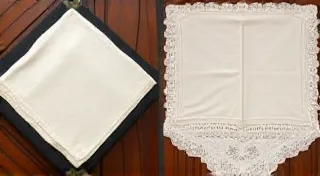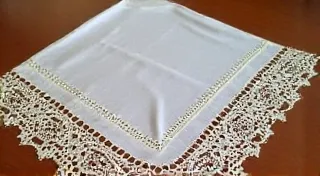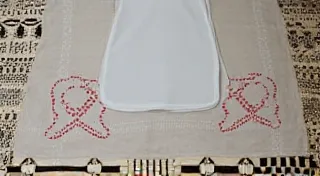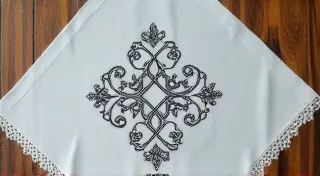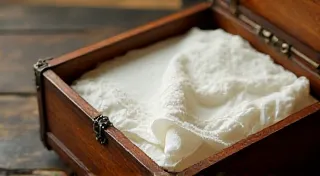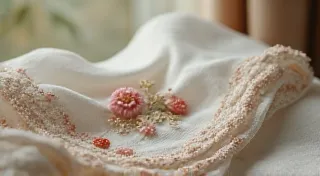Edge Treatments: Point Lace, Drawn Thread, and More
Antique handkerchiefs are more than just squares of fabric; they're miniature works of art, often showcasing intricate and delicate edge treatments. These treatments not only finished the handkerchief but also frequently served as a display of the maker’s skill and the family’s status. Identifying these edge treatments is a crucial step in understanding the handkerchief's history, age, and value. Let's delve into some of the most common and beautiful edge treatments found on antique handkerchiefs.
Point Lace
Point lace is arguably the most prestigious and time-consuming of all edge treatments. It's created by individually knotting fine threads onto a patterned background, essentially "painting" the lace design with thread. There are various types of point lace, including Venetian point, Brussels point, and Mechlin point, each with distinct characteristics. Genuine point lace is incredibly rare and valuable. The complexity involved in creating these pieces is truly remarkable, often requiring months or even years to complete a single handkerchief. Understanding antique lace techniques in general, and point lace specifically, is a rewarding journey into a world of intricate craftsmanship. For those wanting to learn more about the broader spectrum of antique lace creation, exploring Understanding Antique Lace Techniques: Meanders, Filet, and More offers a wonderful introduction.
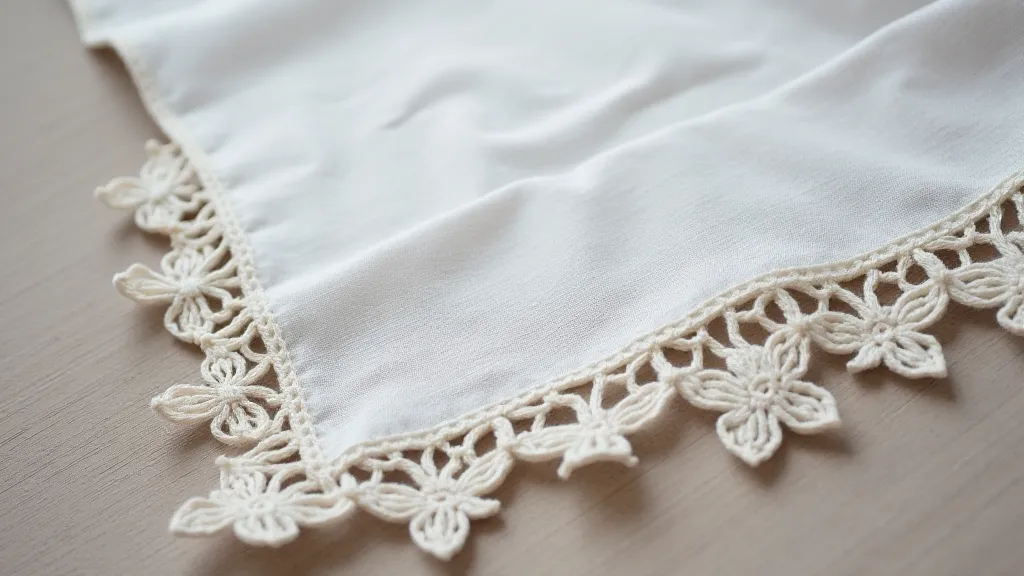
Identifying Characteristics: Look for individual, hand-tied knots, a delicate and airy quality, and a complex, three-dimensional design. It often feels softer and more pliable than other lace types.
Drawn Thread
Drawn thread work is a popular and distinctive edge treatment, characterized by threads being drawn out of the fabric to create a delicate, openwork design. The remaining threads are then often embroidered with fine stitches, adding detail and color to the pattern. The process highlights not only technical skill but also creativity in design; often, the drawn threads form the basis of a larger narrative or decorative motif. The stories these simple squares of linen can tell are often profound, echoing moments in time captured in thread. Sometimes, the sheer effort involved in creating these antique pieces speaks to the whispers of threads that link us to the past, revealing personal narratives woven into the very fabric of these heirlooms.
The Process: The process involves carefully removing every other (or specific patterns of) warp or weft threads from a woven piece of fabric. After the threads are removed, the remaining threads are then worked with various embroidery stitches like satin stitch, back stitch or chain stitch to create patterns and motifs. The variety of stitches employed can dramatically alter the overall look and feel of the finished handkerchief, demonstrating a profound understanding of textile artistry. When learning about drawn thread work, it’s helpful to understand the foundation of common embroidery stitches. Common Embroidery Stitches Explained: A Visual Guide provides a helpful overview for those just starting out.
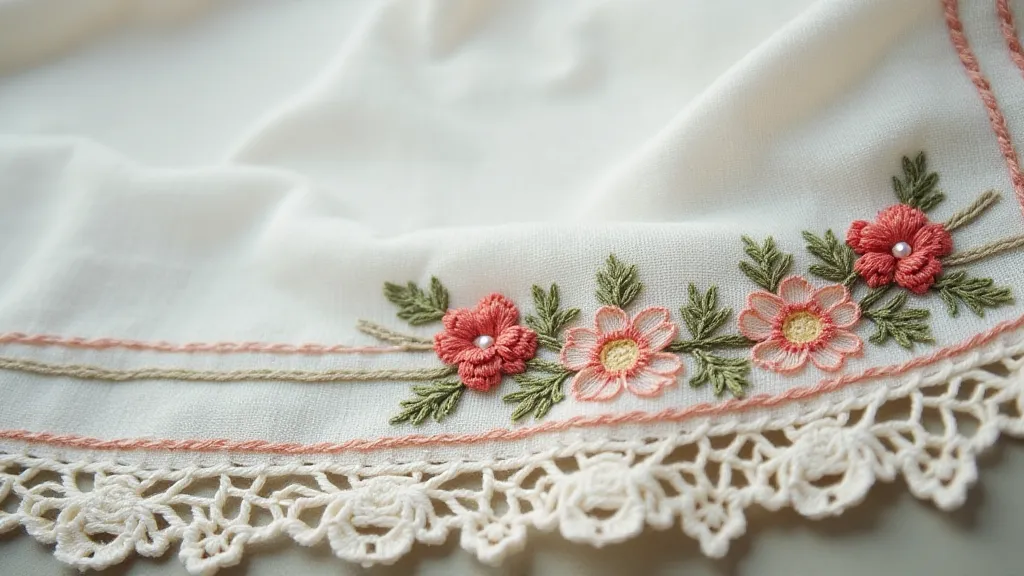
Identifying Characteristics: Look for the distinctive "ladder" effect of the drawn threads, often combined with carefully placed embroidery. The density of the embroidery and the complexity of the drawn thread pattern can indicate the skill level and age of the piece.
Shadow Work
Shadow work is a fascinating technique where areas of the fabric are deliberately left unworked, creating a “shadow” effect that contrasts with the embroidered areas. It’s often used to depict scenes, figures, or intricate floral designs. The artistry lies in the manipulation of light and shade to create a sense of depth and realism, transforming a simple square of fabric into a miniature tableau. The very essence of these pieces speaks to the fleeting nature of memory and the passage of time. Just as ephemeral echoes resonate within antique linens, shadow work captures a moment, preserving it within the delicate weave.
The Technique: Originally, shadow work was achieved by creating a design on plain weave linen or cotton, and then leaving portions of the fabric unworked, creating a design where the background color shows through.
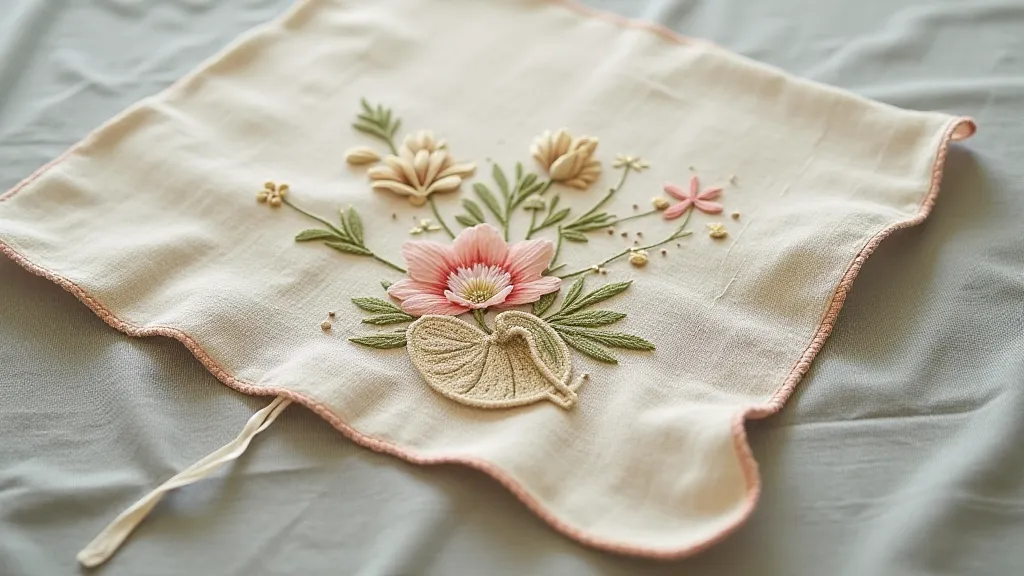
Identifying Characteristics: The key is the presence of deliberately unworked areas, creating a shaded or shadowed effect. The designs are often quite detailed and narrative, depicting scenes or figures.
Other Edge Treatments
While point lace, drawn thread, and shadow work are prominent, other edge treatments are also commonly found on antique handkerchiefs: These treatments, though varying in complexity and visual impact, all contribute to the unique character and historical significance of each handkerchief.
- Broderie Anglaise: Features cutwork and embroidery, creating a lace-like effect. The delicate interplay of cut and embroidered elements makes Broderie Anglaise particularly charming.
- Cutwork: Threads are cut and then re-stitched to create decorative openings. This technique showcases the maker’s ability to manipulate the fabric's structure while maintaining its integrity.
- Eyelet Embroidery: Similar to cutwork, involves cutting the fabric and securing the edges with embroidery. The careful placement and execution of the embroidery around the cut edges contributes to the overall aesthetic appeal.
Many antique handkerchiefs incorporate a combination of these techniques, creating a truly unique and layered design. For those interested in beginning their own journey into hand embroidery on these delicate heirlooms, A Beginner's Guide to Hand Embroidery on Antique Handkerchiefs offers a gentle introduction to the process and materials involved.
The history of these edge treatments isn't just about technique, but about social context. During the Victorian era, for example, the complexity and type of edge treatment often indicated a family’s wealth and status. Intricate point lace, painstakingly created over months, would have been a clear marker of affluence, while simpler drawn thread work might have been more common amongst middle-class families. These handkerchiefs, therefore, offer a window into the social customs and hierarchies of the past. The meticulous nature of the crafting process was often a direct reflection of the family’s position within society. Even the selection of fabric itself was a statement; fine linen or imported cottons were reserved for those with means, while coarser materials were more readily available to the masses.
Examining the materials used is another crucial element in understanding a handkerchief’s age and origin. Linen was the most common fabric, prized for its strength and absorbency, but cotton was also frequently used, particularly in later years. The quality of the fabric itself can provide clues about its intended use - a finer, softer linen might have been reserved for special occasions, while a coarser cotton might have been used for everyday wear. Understanding the nuances in fabric selection, and how that choice related to the overall aesthetic and social signaling of the handkerchief, adds another layer of appreciation for these delicate objects.
The condition of a handkerchief is also an important factor to consider when assessing its value. While minor wear and tear are to be expected, significant damage, such as stains, tears, or fading, can detract from its appeal. Proper storage and handling are essential for preserving these delicate heirlooms for future generations. The fragility of these textiles is a testament to the passage of time; the very act of careful preservation becomes an act of respect for the artisans who created them, and for the memories they represent.
Careful examination of the edge treatments on your antique handkerchiefs will not only help you appreciate their beauty but also provide valuable clues to their origin, age, and value. By understanding these techniques, you’re unlocking a small piece of textile history. The legacy of these creations lies not just in their aesthetic charm, but in the stories they tell about the hands that crafted them and the lives they touched. They are more than just squares of cloth; they are tangible links to a bygone era, whispering secrets of social standing, personal expression, and artistic skill.
